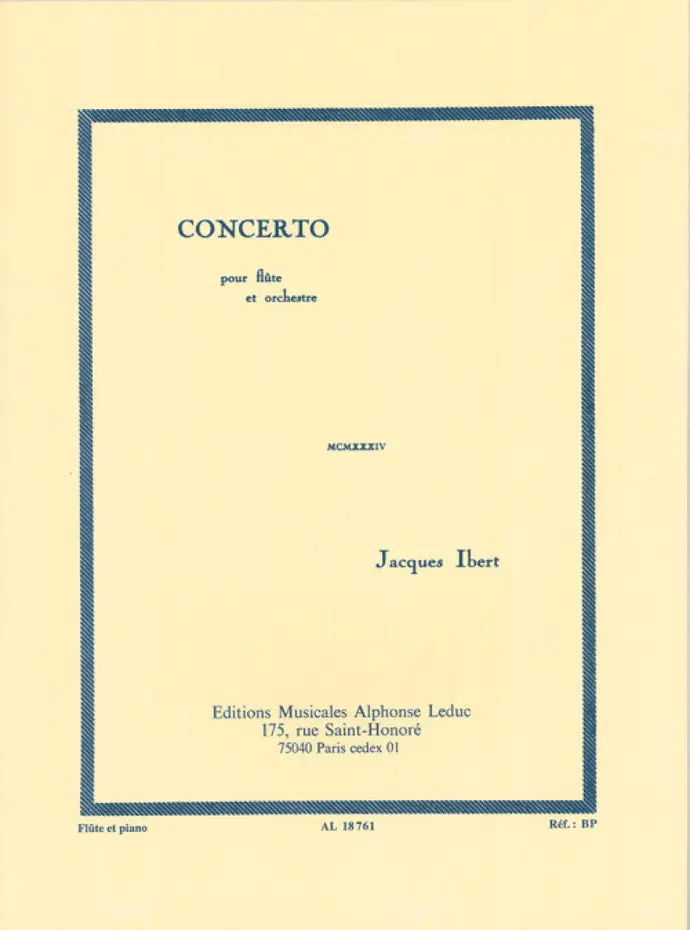
The Premiere of Jacques Ibert’s Flute Concerto
The premiere of Jacques Ibert’s Flute Concerto on February 25, 1934, in Paris, was a defining moment in 20th-century flute music. Composed in 1932-1933, the concerto was written for the virtuoso flutist Marcel Moyse and commissioned by the Paris Conservatoire. The work quickly established itself as one of the most significant contributions to the flute repertoire, celebrated for its technical demands and expressive depth.
Jacques Ibert: A Composer’s Journey
Born in Paris in 1890, Jacques Ibert was a classmate of Arthur Honegger and Darius Milhaud at the Conservatoire. Although not a member of the famed group Les Six, Ibert was on friendly terms with its members and even collaborated with Honegger on the opera L’Aiglon (1937). His career, delayed by his service during World War I, took off in 1924 when the Lamoureux Orchestra premiered his lively and colorful symphonic suite Escales (Ports of Call). This was followed by the success of his one-act opera buffa Angélique in 1927, which became one of the most frequently performed stage works in France during that period.
Ibert also gained recognition for his work on the film Don Quixote (1932), starring Feodor Chaliapin. Despite his embarrassment at winning a secret competition that saw Maurice Ravel’s submission passed over, Ibert’s songs for the film are celebrated for their beauty.
Appointed as the director of the French Academy in Rome in 1937, Ibert’s tenure was interrupted by the Vichy regime during World War II but resumed after the war, lasting until 1960.
The First Performance
The Flute Concerto was first performed by Marcel Moyse, accompanied by the Société des Concerts du Conservatoire, conducted by Philippe Gaubert. The premiere took place at the Salle Gaveau in Paris, amidst a turbulent political atmosphere, just weeks after violent demonstrations on the Place de la Concorde that resulted in 15 deaths and the resignation of the prime minister. Despite these dramatic circumstances, Ibert’s concerto was a celebration of the flute’s technical and expressive possibilities, continuing the legacy of pioneering flutists like Paul Taffanel and Marcel Moyse himself.
Structure and Musical Content
Ibert’s Flute Concerto is structured in three movements, each with distinct character and mood:
Allegro: The opening movement is lively and exuberant, showcasing the flute’s capacities for virtuosity. The movement is characterized by syncopation, rapid passages, and unexpected harmonic shifts that give it a sense of excitement and unpredictability.
Andante: The second movement offers a lyrical contrast, with a flowing, song-like melody that highlights the flute’s expressive potential. This movement is marked by its serene and reflective mood, though it is briefly interrupted by soft, ominous chords in the winds. The movement’s intense but restrained lyricism has been compared to the slow movement of Ravel’s Concerto in G, a near-contemporary work.
Allegro Scherzando: The final movement returns to the high spirits of the first, with playful, rapid passages and intricate interactions between the flute and orchestra. This movement also echoes the quiet mood of the second movement in its middle section before culminating in a dazzling conclusion.
The Importance of the Concerto
Ibert’s Flute Concerto is a cornerstone of the modern flute repertoire, admired for its balance of technical challenge and expressive depth. The work is a quintessential example of French flute music from the early 20th century, embodying the elegance, wit, and clarity that characterize much of the French musical tradition.
The premiere of the Flute Concerto had a profound impact on the flute community. It provided flutists with a major new work that demanded both technical excellence and interpretative sensitivity, raising the bar for what was expected of professional flutists. The concerto’s popularity has only grown since its premiere, with countless performances by flutists around the world.
Conclusion
The premiere of Jacques Ibert’s Flute Concerto was a pivotal event in the history of flute music. Marcel Moyse’s performance brought the work to life, and the concerto has since become one of the most important and frequently performed pieces in the flute repertoire. Its combination of technical brilliance, lyrical beauty, and playful energy continues to inspire flutists and delight audiences, ensuring its place as a timeless masterpiece in the world of classical music.
Listen to the performance of Ibert's Concerto by Marcel Moyse
Premiere of Jacques Ibert’s Flute Concerto

